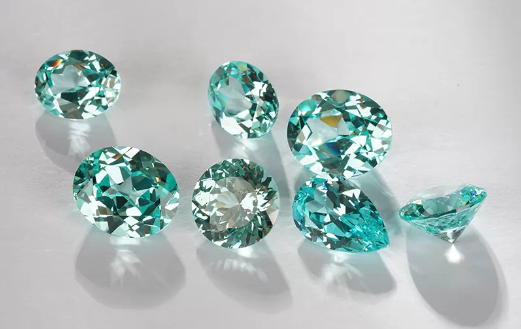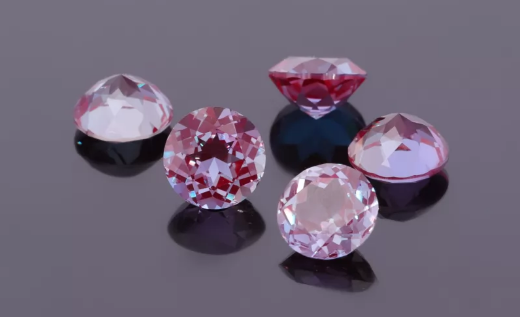To create diamonds in a laboratory, experts start with a "seed," which is a very small diamond gemstone. They then employ one of two different processes: High Pressure High Temperature (HPHT) or Chemical Vapor Deposition (CVD).
In the CVD process, the seed is placed in a plasma reactor chamber where a mixture of carbon-based gases is introduced at low pressure. Microwaves are utilized to heat these gases, creating plasma. As the temperature increases to thousands of degrees, gas molecules start to break up, allowing carbon atoms to bond to the seed, layer by layer.
In the HPHT process, the seed is positioned in a mechanical press, subjecting it to intense temperatures and pressure along with pre-existing carbon. The seed serves as a template for the carbon lattice, shaping the lab-grown diamond. Within a few days, the gemstone undergoes growth, layer by layer, until it reaches the desired carat weight.
How Do Lab Grown Diamonds Get Their Color?
Lab diamonds come in a wide variety of hues ranging from classic white to blush pink to sky blue. Lab grown colored diamonds are made by adding a gas mixture to the CVD reactor and then combining this with specific treatments at the conclusion of the synthesis process. This results in a rich color that would be exceptionally expensive and rare in the natural world.

The Addition of Color: How It's Achieved
Introduction of Trace Elements
The introduction of trace elements during the diamond-growing process is what imparts the vibrant colors to lab-grown diamonds. Various elements, known as dopants, are added intentionally to the diamond crystal lattice. These elements alter the diamond's absorption spectrum, resulting in a stunning array of colors.
Boron for Blue, Nitrogen for Yellow
- Blue Diamonds: The introduction of boron during the growth process is responsible for the captivating blue hues in lab-grown diamonds. The presence of boron atoms within the diamond structure absorbs certain wavelengths of light, giving the gem its characteristic blue color.
- Yellow Diamonds: Nitrogen is a common dopant used to create yellow diamonds. The presence of nitrogen atoms introduces specific color centers within the diamond lattice, leading to the manifestation of vibrant yellow tones.

The Spectrum of Lab-Grown Colored Diamonds
Pink and Red Diamonds
Pink and red lab-grown diamonds owe their color to distortions in the crystal lattice caused by intense pressure during the growth process. These deformities result in the absorption of green light, giving rise to the spectacular pink and red hues.
Green Diamonds
Green lab-grown diamonds are a result of irradiation during the growth process. The exposure to radiation alters the diamond's color by introducing vacancies in the crystal lattice, leading to the manifestation of green shades.
Colored Lab Diamonds Vs. Natural Colored Diamonds
Lab-grown diamonds, whether clear or colored, are indistinguishable from natural diamonds in terms of their chemical and optical properties. The value of these diamonds, just like their mined counterparts, is determined by the 'Four Cs'—cut, color, clarity, and carat weight. When you choose a lab diamond, you can assess its quality based on these essential criteria.
Being manufactured with responsibly sourced materials, lab diamonds are generally considered more eco-friendly than natural diamonds. Additionally, they often come with a lower price tag, allowing consumers to acquire a larger carat weight without the hefty cost. This combination of affordability, luxury, and social responsibility has contributed to the rising popularity of lab diamonds in the jewelry market.
Quality and Certification
GIA Certification
Just like natural diamonds, lab-grown diamonds undergo rigorous testing and certification. The Gemological Institute of America (GIA), a renowned authority in gemology, provides certification for lab-grown diamonds, detailing their color, clarity, cut, and carat weight.
Conclusion
In conclusion, the production of colored lab diamonds involves a meticulous combination of science and technology. By controlling the growth environment and introducing specific trace elements, scientists can craft diamonds in an array of colors that rival their natural counterparts. The beauty of lab-grown colored diamonds lies not just in their vibrant hues but also in the ethical and sustainable approach to diamond production.
If you're interested in exploring the world of lab-grown colored diamonds or have questions about reputable suppliers, feel free to contact us. Our team of experts is ready to guide you in discovering these exquisite gems and ensuring you make an informed and ethical choice for your jewelry needs.



 Lab Grown Emerald
Lab Grown Emerald



